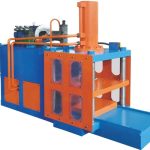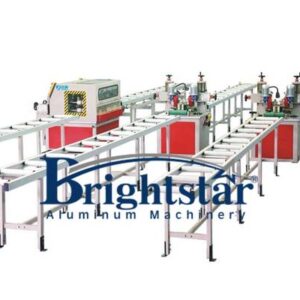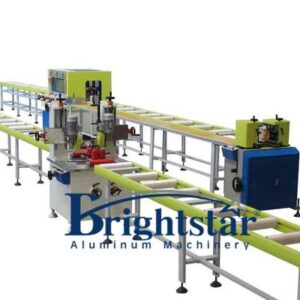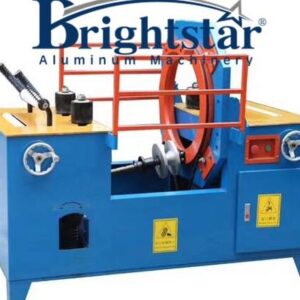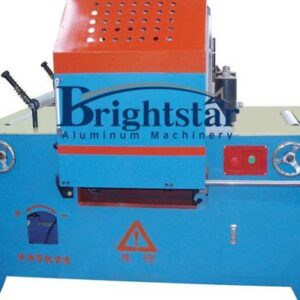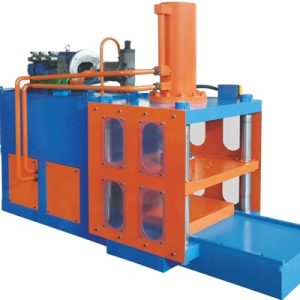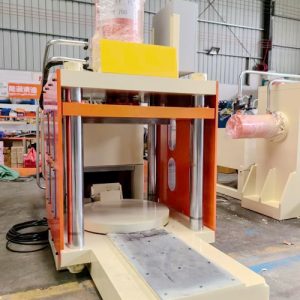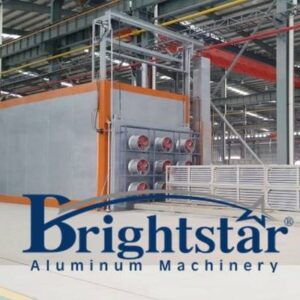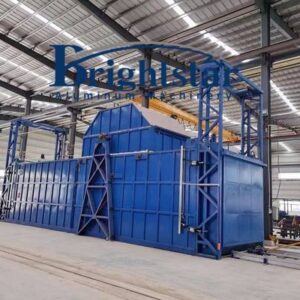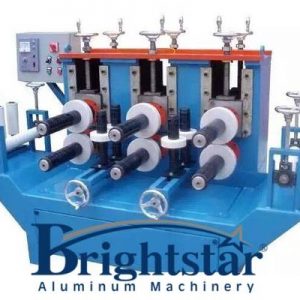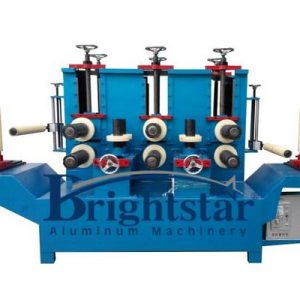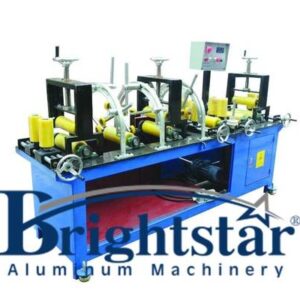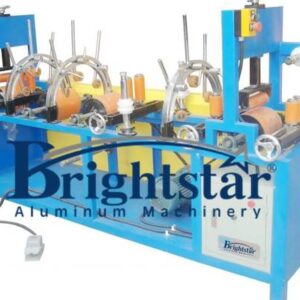- شرح
- استعلام
شرح
سیستم تصفیه مایع قلیایی ضایعات قالب های اکستروژن آلومینیومی
سیستم تصفیه مایع قلیایی ضایعات قالب های اکستروژن آلومینیومی
The waste alkali liquid treatment system is mainly used to treat the high-concentration waste alkali liquid generated by alkali liquid etching cleaning of aluminum extrusion dies.
The equipment system mainly includes the following three parts:
Multifunctional extrusion dies cleaning equipment, waste alkali mist purification equipment مقدار تولید آلومینیوم الکترولیتی جهانی waste alkali liquid recovery and reuse equipment.
The waste liquid generated after cleaning by the multifunctional mold cleaning equipment is uniformly collected in the waste alkali liquid collection pool, and the waste alkali liquid is pumped to the waste alkali liquid recovery and reuse equipment through a pump.
The waste alkaline gas generated during mold etching and cleaning is pumped to the spray tower through a negative pressure fan, subjected to deep desorption and purification treatment, so that it can meet the emission standards after treatment.
The waste alkali recovery and treatment equipment adopts the hydrolysis crystallization method (also known as the Bayer process).
It hydrolyzes the sodium aluminate compound in the waste alkali liquid of the aluminum extrusion dies corrosive cleaning into particulate aluminum hydroxide and sodium hydroxide solution, realizing the secondary recycling of the liquid sodium hydroxide solution, reducing the company’s use of caustic soda, and by-product aluminum hydroxide is collected and sold to create additional income for the company.
The waste alkali liquid recovery system is automatically controlled by PLC program.
There is no need for worker monitoring throughout the process.
The recovery reaction does not require additional heating and cooling.
The system equipment has ultra-low energy consumption.
The complete system treatment produces no waste alkali mist, achieving zero discharge of waste alkali liquid.
Multifunctional extrusion dies cleaning equipment
The multifunctional intelligent extrusion dies cleaning tank is mainly used for mold etching and cleaning.
The extrusion dies cleaning tank can be selected as a single tank or a multi-tank type according to the number and size of the customer’s extrusion dies.
The extrusion dies cleaning tank contains a cleaning tank with a built-in temperature probe, electromagnetic heater and exhaust gas collection port.
The outer wall of the tank is wrapped with high-efficiency thermal insulation cotton and wrapped with high-quality SUS304 board for corrosion protection.
Waste alkali mist purification treatment equipment
The main function of the waste alkali mist purification equipment is to absorb and purify the waste alkali gas generated during extrusion dies cleaning.
The treatment equipment is equipped with a collection duct, a high-efficiency desorption spray tower and a negative-pressure fan.
After being treated by the equipment, it can be directly discharged to meet the standards.
Waste alkali recycling and reuse equipment
Waste alkali recovery and reuse equipment is used for alkali recovery.
It mainly includes waste liquid collection unit, crystallization hydrolysis unit, recovery liquid collection unit and by-product collection unit.
داده های تکنیکی
Equipment space: L19000mm*W8000mm*H6500mm
Inoculating seed storage tank (outdoor): Diameter 3000mm, height 6000mm
Spray tower (outdoor): Diameter 1500mm, height 3000mm
2 extrusion dies cleaning tanks: L1500mm*W1300mm*H1200mm
1 washing tank: L1500mm*W1300mm*1200mm
1 waste alkali tank: L1600mm*W1500mm*H2200mm
1 alkali tank: L1600mm*W1500mm*H2200mm
Reaction tank: L1600mm*W1500mn*H2200mm
Decomposition equipment: L1800mm*W2100mm*H4000mm
Features of the system
Process for processing extrusion dies cleaning caustic soda reuse: extrusion dies cleaning caustic soda, heating, cleaning, spraying are all available, the operation is very convenient, and it is highly efficient and energy-saving.
The caustic soda can be saved by 90%, the tap water consumption can be saved by 99%, and the cost of aluminum removal agent is only equivalent to 10-15% of caustic soda.
1. Save more than 90% of the use of caustic soda and 99% of the use of tap water.
2. Avoid risks and reduce expenses. Traditional de-molding wastewater is absolutely hazardous waste, which requires qualified enterprises to recycle and treat. The current treatment cost is more than 2,000/ton.
3 Zero discharge throughout the treatment process.
4 The solid precipitate produced at the end can be sold normally to recover part of the cost.
It fundamentally solves the problems of large caustic soda consumption, small amount of aluminum recovery, harsh working environment and unsafe conditions in the alkali cleaning process of aluminum extrusion dies.
همزمان, the alkali cleaning waste liquid recovery system can effectively recover the excess alkali solution in the waste liquid for extrusion dies cleaning and separate the aluminum ions through chemical methods, thereby achieving zero wastewater discharge in the extrusion die alkali cleaning process, recovering aluminum ions and improving economic benefits.
The fully automatic aluminum extrusion die alkali cleaning and waste liquid comprehensive recycling system is system equipment that uses advanced sensors, process automatic control, breakthrough process operation methods and other new technologies to achieve efficient, و دو تکه پروفیل آلومینیومی توسط نوار پلی آمید به هم متصل خواهند شد, pollution-free and safe mold alkali washing cleaning treatment.
Why is it necessary to carry out the aluminum extrusion dies cleaning process?
Introduction
این قالب اکستروژن is a key component in the aluminum extrusion production process.
When the die is removed after the extrusion machine is used, a certain amount of scrap aluminum will be stuck in the die hole, affecting the repair and reuse of the die.
The extrusion die cleaning process is to use a crane or hoist to lift the die into an alkali tank filled with sodium hydroxide solution.
After the scrap aluminum adhering to the die hole is partially dissolved, the die is cleaned and the scrap aluminum is knocked out.
The cleaned die is then repaired or put back into use.
The cleaning process of aluminum extrusion dies will produce waste liquid containing alkali and aluminum.
The current situation of extrusion die cleaning
The process of aluminum extrusion dies cleaning is to immerse the die in a sodium hydroxide solution, which will dissolve the aluminum metal, thus making the die clean and easy to use again.
با این حال, the sodium hydroxide solution will quickly enrich the dissolved aluminum.
As it continues to dissolve more aluminum, its dissolving ability decreases until it is completely lost, so the sodium hydroxide solution must be replaced frequently.
During the extrusion die cleaning process, the waste aluminum in the die hole undergoes the following chemical reactions in the sodium hydroxide solution:
Removal of the natural oxide film of aluminum:
Al2O3+2NaOH==2NaAlO2+H2O(g)↑ (water vapor)
Dissolved aluminum: 2Al+2NaOH+2H2O==2NaAlO2+3H2↑
Solution decomposition: NaAlO2+2H2O==Al(OH)3↓+NaOH
در تولید واقعی, the mass concentration of sodium hydroxide in the extrusion dies cleaning process is about 200g/L~300g/L (mass fraction is about 16.7%~23.1%), and the peak temperature of the dies cleaning process can reach 100°C.
The extrusion die cleaning time depends on the specific conditions of the die (die type, die size, whether the extrusion die is urgently needed, و غیره.)
The following are the main problems encountered by extrusion die cleaning operations in their daily production operations:
1. Unorganized and unplanned addition of sodium hydroxide, resulting in high consumption of sodium hydroxide;
2. Replacing sodium hydroxide solution based on experience, resulting in serious waste;
3. Prolonging extrusion dies cleaning time to save trouble.
An enterprise with an annual output of 200,000 tons of aluminum profiles consumes about 2,000 tons of sodium hydroxide in the extrusion dies cleaning process, and produces about 8,000 tons of dies cleaning waste liquid containing alkali and aluminum.
The extrusion dies cleaning process consumes a large amount of sodium hydroxide, and a large amount of acid is also required to treat a large amount of mold-making waste liquid.
Experimental Research
Based on the observation and understanding of the actual production situation of the extrusion dies cleaning process, combined with the chemical reactions that occur in the extrusion dies cleaning process, the factors that have a greater impact on the dies cleaning efficiency are:
1. Dies cleaning time;
2. Sodium hydroxide concentration;
3. Dies cleaning temperature.
سایر اجزای آلیاژ مایع باقی می مانند و در نواحی بین دانه های فاز اولیه تجمع می یابند, the experiment is mainly conducted based on these three factors, and the changes in the concentration of each substance in the dies cleaning waste liquid are explored.
Effect of reaction time on dissolving aluminum metal
Effect of reaction time on dissolving aluminum metal, take 7 small cylindrical aluminum rods (diameter D=21mm, length L=100mm), weighing 92.3±0.1g, and prepare 7 portions of 500mL sodium hydroxide solution with a mass concentration of 300g/L.
The aluminum rods were placed in the sodium hydroxide solution for 1, 2, 3, 4, 5, 6, مقدار تولید آلومینیوم الکترولیتی جهانی 12 hours respectively.
After reaching the target time, measure the total alkali concentration, free sodium hydroxide concentration, aluminum ion concentration and solution temperature of the solution.
Take out the aluminum rods, wipe it clean with filter paper, and weigh the aluminum rods.
The experimental phenomena are as follows:
(1) Bubbles emerge from the surface of the aluminum rods. The number of bubbles increases gradually at first and then decreases after a period of time;
(2) The solution releases heat during the reaction. The solution gradually heats up to boiling at first and stops boiling after a period of time;
(3) The color of the solution gradually changes from white to gray. As the reaction time increases, the color of the solution deepens and becomes more turbid;
(4) The liquid level of the solution gradually decreases;
(5) A gray-black precipitate is generated at the bottom of the solution and gradually increases.
As the reaction time increases, the total alkali concentration increases.
This is because aluminum reacts with sodium hydroxide solution to form sodium aluminate, and the sodium aluminate hydrolyzes: AlO2-+2H2O Al(OH)3+OH-, making the solution strongly alkaline.
علاوه بر این, the solution contains unconsumed sodium hydroxide, so the total alkali concentration continues to increase.
As the reaction time increases, the free sodium hydroxide concentration gradually decreases, and the aluminum ion concentration gradually increases.
After about 3 hours of reaction, the changes in the free sodium hydroxide concentration and the aluminum ion concentration tend to be stable.
This is because as the reaction time increases, more and more aluminum is enriched and dissolved in the sodium hydroxide solution, and the aluminum ion concentration increases.
When more aluminum continues to be dissolved, the solubility of the sodium hydroxide solution gradually decreases, so the rate of change of the free sodium hydroxide concentration and the aluminum ion concentration gradually decreases.
When the aluminum rods comes into contact with the sodium hydroxide solution, the temperature of the solution rises.
This is because the dissolution of sodium hydroxide in water is an exothermic physical reaction, and the reaction of aluminum with the sodium hydroxide solution is an exothermic chemical reaction, which causes the solution temperature to rise to boiling, and then the temperature gradually decreases.
As the reaction time increases, the weight of the aluminum rod gradually decreases.
After about 3 hours of reaction, the change in the weight of the aluminum rod tends to be stable.
This is because as the reaction time increases, the solubility of the sodium hydroxide solution gradually decreases, so the reaction rate of the aluminum rod and the sodium hydroxide solution gradually decreases.
Within about 3 hours after the reaction started, the aluminum rod reacted with the sodium hydroxide solution at a faster speed;
After about 3 ساعت ها, the aluminum rod reacted with the sodium hydroxide solution at a slower speed, which was significantly reduced compared with the speed of the aluminum rod reacting with the sodium hydroxide solution within about 3 hours after the reaction started.
Considering the actual production situation, the extrusion dies cleaning time is controlled at about 3 ساعت ها, and the dies cleaning efficiency is relatively high.
Extending the extrusion dies cleaning time has no obvious effect on the dissolution of waste aluminum.
Effect of sodium hydroxide concentration on the dissolution of aluminum metal
بگیر 5 pieces of small cylindrical aluminum rods (diameter D=21mm, length L=100mm), weighing 92.3±0.1g, and prepare 5 portions of 500mL sodium hydroxide solution with mass concentrations of 210g/L, 240g/L, 270g/L, 300g/L, and 330g/L, به ترتیب.
بگیر 5 pieces of aluminum rods, place them in the sodium hydroxide solution respectively, and immediately mark the liquid level on the beaker wall with a marker.
Every hour, take out the aluminum rod, wipe it clean with filter paper, and weigh it.
Then put the aluminum rod back into the sodium hydroxide solution and add normal temperature tap water to the mark.
The higher the sodium hydroxide concentration, the faster the weight of the aluminum rod decreases.
From the effect of reaction time on the dissolution of aluminum metal, it can be seen that the efficiency of dissolving aluminum metal is higher when the reaction time is controlled at about 3 ساعت ها.
When the reaction time is 3 ساعت ها, the weight reduction of the 5 pieces of aluminum rods with the above concentrations of 210g/L, 240g/L, 270g/L, 300g/L, and 330g/L is 26.84g, 37.82g, 42.19g, 49.91g, and 53.63g respectively.
The weight reduction of aluminum rods with adjacent concentrations that have reacted for 3 hours is subtracted and the absolute value is taken, which is: 10.98g, 4.37g, 7.72g, and 3.72g respectively.
When the reaction time is 3 ساعت ها, the weight reduction of the aluminum rod in the sodium hydroxide solution with a concentration of 240g/L is much greater than that of the aluminum rod in the sodium hydroxide solution with a concentration of 210g/L (10.98g).
سایر اجزای آلیاژ مایع باقی می مانند و در نواحی بین دانه های فاز اولیه تجمع می یابند, it is recommended to use a sodium hydroxide solution with a concentration of ≥240g/L to dissolve aluminum metal;
When the reaction time is 3 ساعت ها, the weight reduction of the aluminum rod in the sodium hydroxide solution with a concentration of 330g/L is much less than that of the aluminum rod in the sodium hydroxide solution with a concentration of 300g/L (3.72g).
سایر اجزای آلیاژ مایع باقی می مانند و در نواحی بین دانه های فاز اولیه تجمع می یابند, it is recommended to use a sodium hydroxide solution with a concentration of ≤300g/L to dissolve aluminum metal.
در تولید واقعی, considering the dissolution rate of scrap aluminum and production cost, it is recommended to use sodium hydroxide solution with a mass concentration of 240g/L to 300g/L for extrusion dies cleaning.
Effect of reaction temperature on the dissolution of aluminum metal
بگیر 2 small pieces of cylindrical aluminum rods (diameter D = 21mm length L = 100mm), weighing 92.3±0.1g, and prepare 2 portions of 500mL sodium hydroxide solution with mass concentrations of 150g/L and 300g/L respectively.
Place the beaker in a constant temperature water bath heating device and set the temperature to 90℃.
بگیر 2 pieces of aluminum rods and place them in sodium hydroxide solution respectively, and immediately mark the liquid level on the beaker wall with a marker.
Take out the aluminum rods every 1 ساعت, wipe them clean with filter paper, and weigh them.
Then put the aluminum rods back into the sodium hydroxide solution and add room temperature tap water to the mark.
Raising the temperature of the sodium hydroxide solution will significantly accelerate the rate of weight reduction of the aluminum rods.
After the low concentration sodium hydroxide solution is heated, the weight reduction rate of the aluminum rods can, to a certain extent, reach the weight reduction rate of the aluminum rods in the high concentration sodium hydroxide solution at room temperature.
As the weight reduction rate of the aluminum rods increases, the evaporation rate of water also increases.
در تولید واقعی, the extrusion dies cleaning alkali tank can be properly heated, and attention should be paid to timely replenishing water to avoid the sodium hydroxide solution level being lower than the mold, thereby affecting the extrusion dies cleaning efficiency.
When supplementing water, the cost should be comprehensively considered, and high-temperature water generated during production in other processes should be added as much as possible to further accelerate the dissolution rate of scrap aluminum.
به طور خلاصه:
The aluminum extrusion dies cleaning process should be based on the chemical reaction that occurs during the washing and cleaning process.
The factors that have a greater impact on the dies cleaning efficiency are: 1. Dies cleaning time; 2. Sodium hydroxide concentration; 3. Dies cleaning temperature.
Comprehensive consideration can make the extrusion dies cleaning efficiency high, سریع, and accurate, and save corporate costs.
The specific process must be estimated and considered by each aluminum profile manufacturer.




